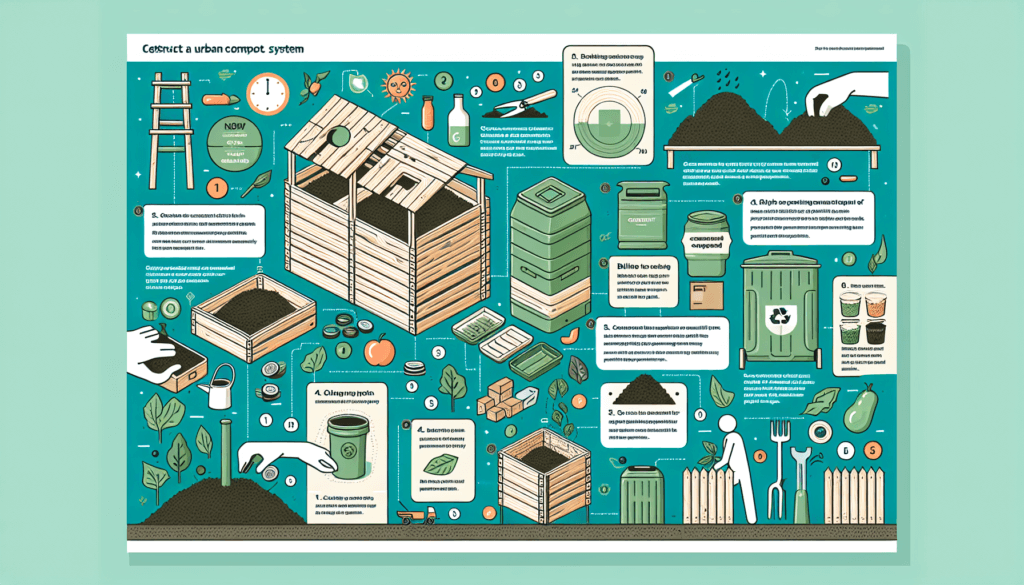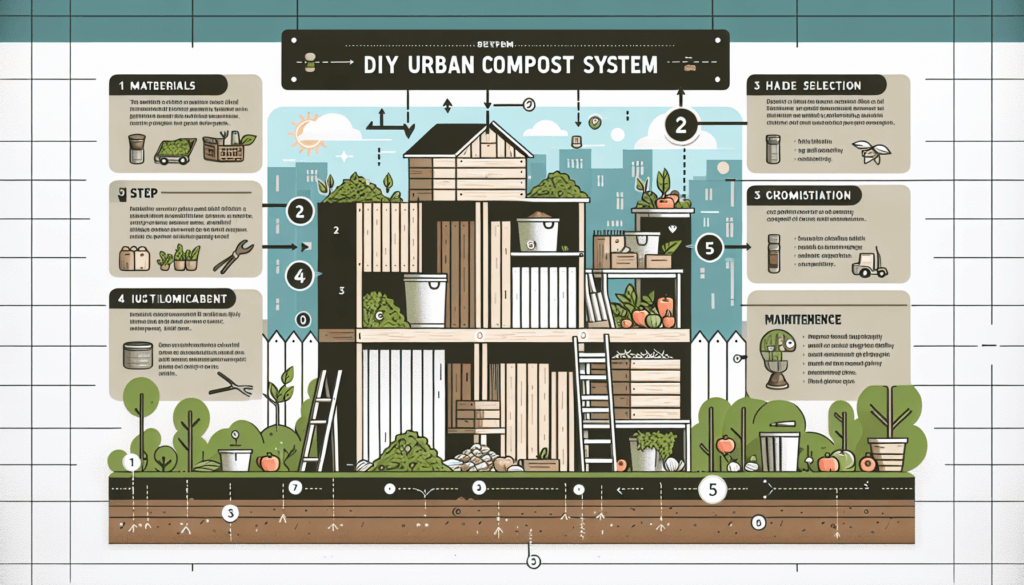If you’re looking for an eco-friendly way to reduce waste and nourish your plants, creating a DIY urban compost system is the perfect solution for you. By following a few simple steps, you can transform your kitchen scraps into nutrient-rich compost right in the heart of your urban living space. With this easy and effective method, not only will you be reducing your carbon footprint, but you’ll also be able to create a sustainable and thriving garden right outside your doorstep. So, roll up your sleeves and get ready to embark on an exciting composting journey!

Choosing the Right Location
When it comes to setting up your DIY urban compost system, one of the first things you need to consider is the location. Finding the right spot is crucial for the success of your composting journey.
Checking for Local Regulations
Before setting up your compost system, it’s essential to check if there are any local regulations or guidelines regarding composting in your area. Some municipalities may have specific rules about composting to ensure it is done in a way that doesn’t pose any health or environmental hazards. By familiarizing yourself with the regulations early on, you can avoid any potential issues down the line and ensure you are composting responsibly.
Determining Available Space
Once you’ve confirmed that composting is allowed in your area, the next step is to determine the available space for your compost system. Whether you have a small balcony or a larger backyard, finding an appropriate spot for your compost pile or container is key.
If you have limited space, consider using a compost bin or container that fits your available area. There are various compact options designed specifically for urban settings, such as small compost tumblers or worm bins. These options allow you to compost effectively even in tight spaces.
Considering Accessibility
While finding a suitable location is important, accessibility is another factor to consider. It’s crucial to choose a spot that is easily accessible so that you can conveniently add compostable materials and maintain your compost pile. Consider placing your compost system near your kitchen or gardening area to make it readily accessible when you need it.
Selecting the Right Container
Once you have determined the perfect location for your DIY urban compost system, it’s time to select the right container. The choice between an indoor or outdoor container largely depends on the available space and personal preference.
Choosing Between Indoor and Outdoor Containers
If you have limited outdoor space or prefer to compost indoors, there are various indoor composting options available. Worm bins, also known as vermicomposting, are an excellent choice for indoor composting. These bins use worms to break down organic materials into nutrient-rich compost. They are compact, odorless, and can be easily maintained in apartments or small houses.
If you have an outdoor space such as a backyard or balcony, outdoor compost containers provide more flexibility. Traditional compost bins or tumblers can accommodate larger volumes of compostable materials. They allow for natural aeration and decomposition, resulting in high-quality compost for your gardening needs.
Evaluating Container Size
When selecting a container for your compost system, it’s essential to consider the size. The size of the container will depend on the amount of compostable materials you generate and the space available. A general rule of thumb is to have a container that is at least three feet wide and tall. This size allows for proper air circulation and decomposition.
If you generate a large amount of organic waste, consider using multiple containers or investing in a larger compost bin or tumbler. However, make sure the size is manageable for your available space and that you can easily maintain and turn the compost.
Considering Aesthetic Factors
While functionality should be the primary consideration when selecting a compost container, aesthetic factors can also play a role, especially in urban settings. If you want your compost system to blend seamlessly into your urban environment, consider containers that are visually appealing or can be disguised as decorative elements in your garden or balcony.
There are compost bins available in various designs and colors that can match your personal style and add an aesthetic touch to your urban composting setup. By selecting a container that complements your outdoor space or indoor decor, you can create a visually appealing composting system that integrates seamlessly with your urban lifestyle.

Collecting Compostable Materials
Once you have set up your DIY urban compost system, the next step is to start collecting compostable materials. Composting involves a mixture of green and brown materials, each contributing to the nutrient-rich composition of the final compost.
Identifying Green and Brown Materials
Green and brown materials are the two main categories of compostable materials. Green materials are typically high in nitrogen and provide a crucial source of protein for the microorganisms responsible for decomposition. Examples of green materials include fruit and vegetable scraps, coffee grounds, grass clippings, and fresh plant trimmings.
On the other hand, brown materials are high in carbon and help create a diverse and well-balanced compost pile. Brown materials include dry leaves, straw, wood chips, shredded paper, and cardboard. These materials provide structure to the compost pile, promote aeration, and help prevent odors.
Listing Common Green Materials
To ensure a successful composting process, it’s important to have a variety of green materials in your compost pile. Fruit and vegetable scraps from your kitchen are excellent green materials to include. Coffee grounds, tea bags, and eggshells are also valuable additions that provide essential nutrients to the compost.
Grass clippings from your lawn maintenance and fresh plant trimmings from your garden are other common green materials that can be readily used. By including a mix of these materials, you contribute to a balanced compost pile with sufficient nitrogen content.
Listing Common Brown Materials
Brown materials are equally important in the composting process as they contribute to the carbon-to-nitrogen ratio. Dry leaves, straw, and wood chips are readily available brown materials that can be collected from your surroundings. Shredded paper and cardboard, such as newspaper or cardboard boxes, are also excellent choices to incorporate into your compost pile.
By having a steady supply of brown materials, you ensure proper decomposition and prevent the compost pile from becoming too wet or smelly. Remember to shred larger brown materials, such as cardboard, into smaller pieces to facilitate quicker decomposition.
Maintaining the Compost Pile
After collecting the necessary compostable materials, maintaining the compost pile becomes essential to achieve optimal decomposition and nutrient-rich compost.
Layering Green and Brown Materials
A crucial aspect of maintaining the compost pile is layering green and brown materials. The layering process helps create a balanced ratio of carbon to nitrogen, promoting efficient decomposition. Ideally, you should have approximately three parts brown materials for every one part green material.
Start by adding a layer of brown materials at the bottom of the compost pile or container. Then, add a layer of green materials on top, ensuring an even distribution. Repeat the layering process, alternating between green and brown materials, until the compost pile reaches the desired height. Maintaining this layering technique throughout the composting process helps create an optimal environment for decomposition.
Maintaining Proper Moisture Levels
Moisture is a critical factor in the composting process. A compost pile that is too dry will decompose slowly, while excessive moisture can lead to undesirable odors and attract pests. It’s crucial to maintain proper moisture levels to support the microbial activity responsible for decomposition.
Aim for a moisture content similar to a wrung-out sponge. Regularly monitor the moisture levels of your compost pile and add water when necessary. If the pile becomes too wet, incorporate more brown materials to absorb the excess moisture. Conversely, if the pile is too dry, add water or sprinkle some green materials to increase moisture content.
Turning the Pile Regularly
To ensure even decomposition and airflow, it’s important to turn the compost pile regularly. Turning or aerating the pile helps distribute the microorganisms and nutrients throughout the pile, accelerating the decomposition process. Aim to turn the pile every one to two weeks, using a pitchfork or shovel to mix the materials thoroughly.
Turning the pile also helps prevent the formation of anaerobic pockets, reducing the likelihood of unpleasant odors. As you turn the pile, check for any dry or compacted areas and add water or brown materials as needed. Regularly turning the compost pile contributes to a faster composting process and yields high-quality compost in a shorter timeframe.

Accelerating the Composting Process
While composting occurs naturally over time, there are several ways to accelerate the process and obtain compost more quickly.
Using Composting Accelerators
Composting accelerators, also known as compost starters or activators, are products designed to enhance the decomposition process. These accelerators typically contain a combination of microorganisms, enzymes, and organic matter that speed up the breakdown of organic materials.
When using composting accelerators, make sure to follow the manufacturer’s instructions and dosage recommendations. While they can be beneficial in certain situations, they are not always necessary for a successful composting process. Proper layering, moisture control, and regular turning of the compost pile can often produce excellent results without the need for additional accelerators.
Adding Worms to the Compost
For those utilizing a worm bin or vermicomposting system, adding worms can significantly speed up the composting process. Worms, such as red wigglers, feed on organic materials and accelerate their decomposition. They also enrich the compost with beneficial microorganisms and enhance its nutrient content.
When introducing worms to your compost system, ensure that the environment is suitable for their survival. Maintain the proper moisture levels and provide enough organic waste to sustain them. Monitor the population of worms and adjust their numbers accordingly, as they reproduce and multiply in a healthy composting environment.
Monitoring and Adjusting Carbon-to-Nitrogen Ratio
Maintaining an optimal carbon-to-nitrogen (C:N) ratio is crucial for efficient composting. The ideal C:N ratio ranges from 25:1 to 30:1, ensuring a balanced mix of green and brown materials for successful decomposition. However, the C:N ratio can vary depending on the types of materials used.
Monitor the C:N ratio of your compost pile regularly to ensure a healthy decomposition process. If the decomposition is too slow or there is an imbalance in the compost, you may need to adjust the C:N ratio. Add more green materials if the decomposition is slow or more brown materials if the compost pile is too wet and smelly. By carefully managing the C:N ratio, you can accelerate the composting process and produce high-quality compost more efficiently.
Managing Odor and Pest Control
Proper management of odor and pest control is essential to maintain a pleasant composting experience and prevent any nuisances in your urban environment.
Covering the Compost Pile
One effective way to manage odors and discourage pests is by covering your compost pile or container. Covering helps control odor by trapping the organic scent within the compost and preventing it from dispersing into the surrounding area. It also acts as a barrier, preventing pests from accessing the compost and potentially causing any disruptions.
Use a breathable cover, such as a tarp or a specially designed compost cover, that allows for adequate airflow while still keeping unwanted odors and pests at bay. Remember to secure the cover properly to prevent it from blowing away in strong winds or inclement weather conditions.
Adding Citrus Peels or Coffee Grounds
To naturally combat unwanted odors in your compost pile, consider adding citrus peels or coffee grounds. Citrus peels not only help mask any unpleasant smells but also provide essential nutrients to the compost. Coffee grounds, apart from their odor-neutralizing properties, are an excellent nitrogen-rich addition to the pile.
Regularly incorporating citrus peels or coffee grounds will not only help minimize odors but also contribute to the overall nutrient content of the compost. However, use these materials in moderation, as excessive quantities can affect the pH balance of the compost pile.
Implementing Pest Control Measures
While composting can attract some pests, there are measures you can take to prevent their intrusion and keep your compost system pest-free. One effective strategy is to bury any food waste or green materials within the compost pile. By burying the organic matter, you create a less accessible environment for pests and deter them from being attracted to the compost.
Additionally, avoid adding any meat, dairy products, or oily substances to the compost pile, as these can attract unwanted pests. Regularly check the compost system for signs of pests and address any issues promptly. If pests become a persistent problem, consider using natural pest control methods or consult with local experts for effective solutions.

Harvesting and Using the Compost
Once your compost pile has undergone the decomposition process and transformed into rich, dark, crumbly compost, it’s time to harvest and put it to use in your urban garden.
Determining When the Compost is Ready
Composting is a gradual process, and the time it takes for the materials to fully decompose can vary. One way to determine if your compost is ready is by visually inspecting it. Mature compost has a dark color, an earthy smell, and a crumbly texture. The original materials should be unrecognizable, and there should be no signs of decomposition or rotting.
Another method is the “hand test.” Take a handful of the compost and squeeze it lightly in your hand. If it remains together and just slightly crumbles when you open your hand, it is an indication that the compost is ready.
Sifting and Storing the Compost
Before using the compost, it’s beneficial to sift it to remove any larger debris or unfinished materials. This step ensures a consistent texture and quality in your final product. You can use a mesh screen or a compost sifter to easily separate the mature compost from any remaining bulky materials.
Once sifted, store the compost in a suitable container or bin until you are ready to use it. Consider using a covered container to protect the compost from excess moisture or pests. Alternatively, you can incorporate the compost directly into your garden soil or use it as a top dressing for your plants.
Using the Compost in Urban Gardening
One of the primary benefits of composting is the production of nutrient-rich soil amendments that can greatly benefit your urban garden. Compost improves soil structure, water retention, and nutrient availability for plants, leading to healthier and more productive gardens.
In urban gardening, where space may be limited, compost can be used in various ways. Mix compost into potting mixes when planting in containers or raised beds to provide a nutrient boost to your plants. Apply a layer of compost as a natural mulch around existing plants to suppress weeds and conserve moisture. Compost can also be brewed into compost tea, a liquid fertilizer, and applied directly to the roots of plants.
By utilizing the compost produced from your DIY urban compost system, you contribute to the overall health and fertility of your urban garden and create a sustainable gardening solution.
Maintaining the DIY Compost System
To ensure the ongoing success of your DIY urban compost system, it’s important to maintain it regularly and make necessary adjustments as needed.
Regularly Adding Compostable Materials
Maintaining a steady supply of compostable materials is vital to the continuous functioning of your composting system. As you generate food waste or yard trimmings, ensure they are added to the compost pile regularly. Separate kitchen scraps from non-compostable waste and designate a convenient bin or container to collect them until they can be added to the compost pile.
By regularly adding fresh materials, you ensure a healthy mix of green and brown materials and maintain the necessary balance for efficient decomposition. Keeping a consistent supply of compostable materials also helps prevent any interruptions in the composting process.
Avoiding Contaminated Materials
To maintain a healthy compost system, it’s important to avoid adding any contaminated materials that may disrupt the decomposition process or introduce harmful substances into the compost. Avoid adding meat, bones, dairy products, or oily substances, as they can attract pests, cause odors, and potentially contaminate the compost.
Additionally, be mindful of any pesticides, herbicides, or chemicals that may be present on plant materials added to the compost pile. It’s best to avoid using materials that may contain these substances, as they can negatively impact the microbial activity and overall quality of the compost.
Preventing Excessive Moisture or Drying Out
Proper moisture control is essential for the health of your compost pile. While regular watering is important to maintain an adequate moisture level, it’s equally crucial to prevent excessive moisture or drying out.
Monitor the moisture content of your compost pile regularly to ensure it remains damp but not overly wet. If the pile becomes too moist, add more brown materials to absorb the excess moisture. On the other hand, if the pile is drying out, water it lightly or add more green materials to increase moisture levels. By maintaining the right moisture balance, you create an optimal environment for decomposition and prevent any issues related to excessive moisture or drying out.

Troubleshooting Common Issues
Even with proper maintenance, it’s common to encounter issues or challenges during the composting process. By being aware of potential problems and knowing how to address them, you can overcome any obstacles that may arise.
Identifying Potential Problems
Composting can face various challenges, some of which include slow decomposition, foul odors, pests, or mold growth. Slower decomposition can be caused by a lack of nitrogen-rich materials or improper moisture levels. Foul odors may indicate excessive moisture or the presence of materials that should not be composted.
Pests, such as fruit flies or rodents, may be attracted to your compost pile if it contains food waste or meat products. Mold growth can occur if the compost pile is too wet or lacks proper aeration. Regularly inspect your compost system to identify any potential problems and take appropriate action to address them.
Solving a Smelly Compost Pile
Foul odors emanating from your compost pile can be an indication of improper decomposition or excessive moisture. To solve this issue, first, ensure that you have a balanced mix of green and brown materials. If the odor persists, check the moisture level of the pile and adjust as needed. Add more brown materials to absorb excess moisture or turn the pile to promote better aeration.
Avoid adding meat, dairy products, or oily substances, as they can contribute to unpleasant smells. By addressing the underlying causes and maintaining a well-balanced compost pile, you can eliminate the foul odors and create a more pleasant composting experience.
Addressing Pests or Mold
Pests and mold can sometimes find their way into your compost pile, causing disruptions and potentially impacting the quality of the compost. To address pests, ensure that you are not adding any food waste or meat products to the compost pile, as these can attract unwanted visitors. Burying these materials deeper within the compost or covering the pile can also help deter pests.
Mold growth is often a result of excessive moisture or poor aeration. If you notice mold in your compost, turn the pile to improve airflow and adjust the moisture levels by adding more brown materials. Properly managing moisture and turning the pile regularly will help prevent mold growth and maintain a healthy composting environment.
Benefits of Urban Composting
Embarking on a DIY urban composting journey offers numerous benefits beyond just reducing organic waste. Here are some of the key advantages of urban composting:
Reducing Organic Waste in Landfills
One of the significant benefits of urban composting is diverting organic waste from landfills. By composting your food scraps, yard trimmings, and other organic materials, you significantly reduce the amount of waste that ends up in landfills. This not only helps alleviate the strain on landfill capacity but also reduces the production of harmful greenhouse gases, such as methane, which are generated during the decomposition of organic waste in anaerobic landfill conditions.
Creating Nutrient-Rich Soil Amendments
Composting transforms organic waste into nutrient-rich soil amendments that can greatly improve soil health. The finished compost contains essential macronutrients and micronutrients that support plant growth and provide a balanced medium for urban gardening. By incorporating compost into your garden soil or potting mix, you enhance its fertility, structure, and water-holding capacity, resulting in healthier plants and increased yields.
Promoting Sustainable Urban Living
Urban composting contributes to sustainable urban living by closing the nutrient loop and promoting a circular economy. By composting organic waste locally, you reduce the need for chemical fertilizers or peat-based soil amendments, conserving resources and minimizing environmental impact. Composting also promotes community engagement and environmental awareness, fostering a sense of responsibility towards our planet and the importance of reducing waste.
In conclusion, creating a DIY urban compost system allows you to actively participate in sustainable practices and make a positive impact on the environment. By choosing the right location and container, maintaining the compost pile, accelerating the composting process, managing odor and pests, and effectively using the compost produced, you can successfully compost in an urban setting. Embracing urban composting not only reduces organic waste and creates valuable soil amendments but also promotes sustainable living and contributes to a greener, healthier future.


